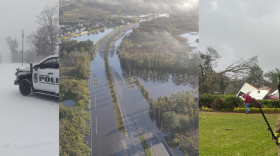Editor's note: A Spanish language version follows (versión en español abajo).
Hurricane Helene continues to become even stronger. It grew into a Category 4 storm, the National Hurricane Center said, Thursday evening shortly before 6:30.
In the 5 p.m. bulletin, the National Hurricane Center says Helene holds maximum sustained winds of 125 mph and is moving even faster at 23 mph to the north-northeast. As the hurricane inches closer, a catastrophic and deadly storm surge will start along parts of the Panhandle and Big Bend. Large waves are already slamming against the Gulf Coast of Florida, and waters will continue to rise as the storm moves northward.

Large wind storm
Power outages have doubled in the last two hours, and over 200,000 customers are now without power. Power outages will continue to increase across the state and will be widespread across the Panhandle.
Wind will quickly start to increase and penetrate across the Panhandle. Violent winds or at least 130 mph will affect the areas where the eye lands, especially to the right or east of the center.

Storm Surge
Up to 20 feet of storm surge is still possible across the Big Bend and parts of the Apalachicola area. Up to 8 feet of storm surge is also possible across the west portion of west-Central Florida.

Flash floods likely
Rainfall will be extensive, especially across the panhandle of north Florida. Flash flooding is possible, especially as Helene inches closer. Heavy rains will continue to move up the state. Some of these heavy rains have had thunderstorms embedded in them.
The tornado watch has expired across South Florida but continues to be in effect for areas north of Lake Okeechobee.

——————(Spanish version)———————
El huracán Helene sigue fortaleciéndose. En el boletín de las 5 p.m., el Centro Nacional de Huracanes dice que Helene tiene vientos máximos sostenidos de 125 mph y se mueve aún más rápido a 23 mph hacia el norte-noreste. A medida que el huracán se acerca, una marejada ciclónica catastrófica y mortal comenzará a lo largo de partes del Panhandle y Big Bend. Grandes olas ya están golpeando contra la costa oeste de Florida, y las aguas continuarán aumentando a medida que la tormenta se mueva hacia el norte.
Gran tormenta de viento
Los cortes de energía se han duplicado en las últimas dos horas, y más de 200,000 clientes ahora están sin energía. Los cortes de energía continuarán aumentando en todo el estado y se extenderán por todo el Panhandle. El viento comenzará a aumentar rápidamente y penetrará en todo el Panhandle. Vientos violentos o de al menos 130 mph afectarán las áreas donde aterriza el ojo, especialmente a la derecha o al este del centro.
Marejada ciclónica
Es posible que se produzcan marejadas ciclónicas de hasta 20 pies en Big Bend y partes del área de Apalachicola. También es posible que se produzcan marejadas ciclónicas de hasta 8 pies en la parte oeste del centro-oeste de Florida.
Probabilidad de inundaciones repentinas
Habrá abundantes lluvias, especialmente en la franja norte de Florida. Es posible que se produzcan inundaciones repentinas, especialmente a medida que Helene se acerca. Las fuertes lluvias seguirán avanzando hacia el norte del estado. Algunas de estas fuertes lluvias han tenido tormentas eléctricas incorporadas.
La vigilancia de tornado ha expirado en el sur de Florida, pero sigue vigente para las áreas al norte del lago Okeechobee.
Copyright 2024 Storm Center







